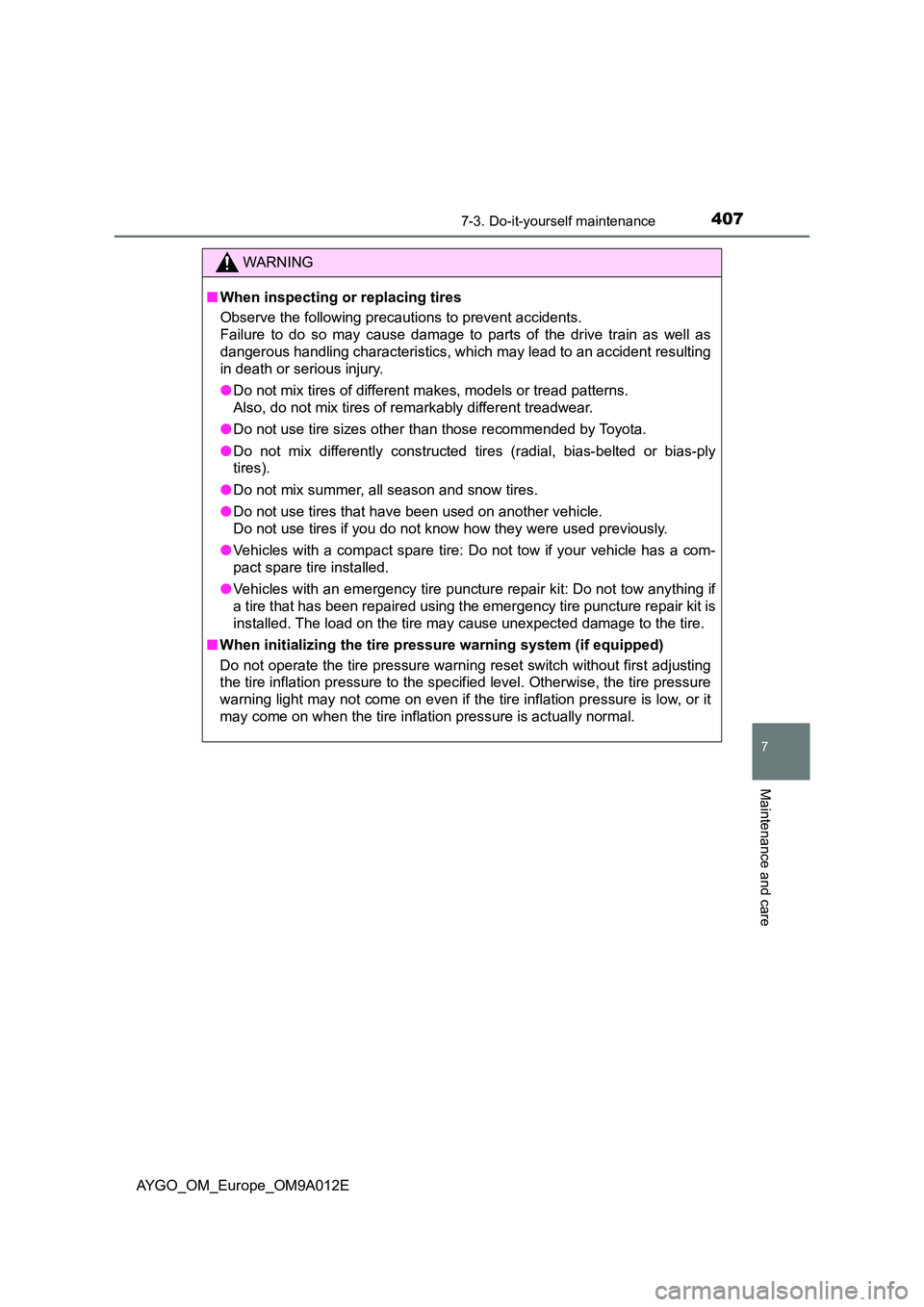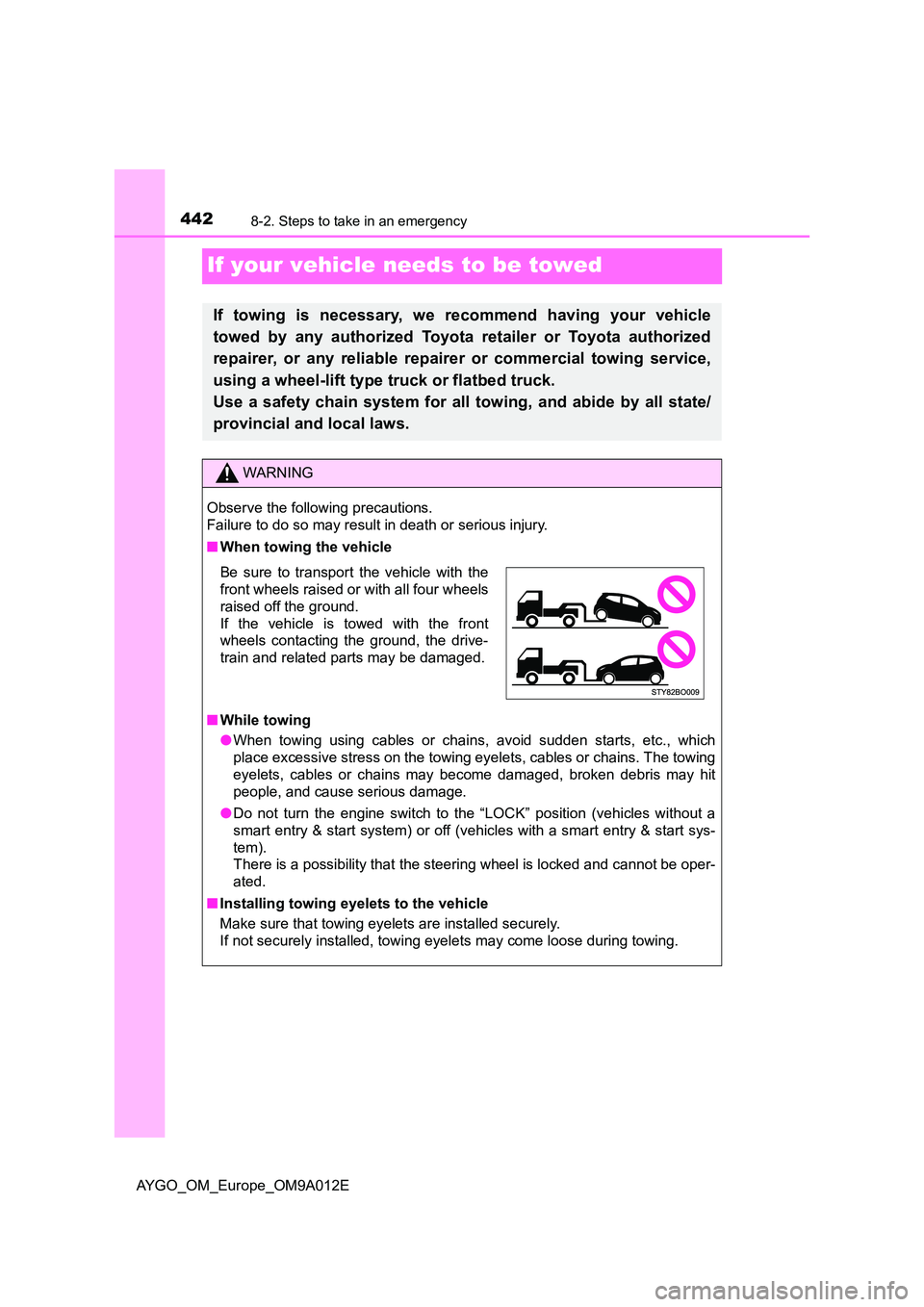Page 389 of 546

3877-3. Do-it-yourself maintenance
7
Maintenance and care
AYGO_OM_Europe_OM9A012E
Do-it-yourself service precautions
If you perform maintenance by yourself, be sure to follow the
correct procedure as given in these sections.
ItemsParts and tools
Battery condition
(P. 399)•Warm water• Baking soda•Grease
• Conventional wrench (for terminal clamp bolts)
Engine coolant
level (P. 397)
• “Toyota Super Long Life Coolant” or a similar high
quality ethylene glycol-based non-silicate, non-
amine, non-nitrite and non-borate coolant with long-
life hybrid organic acid technology
“Toyota Super Long Life Coolant” is pre-mixed with
50% coolant and 50% deionized water.
• Funnel (used only for adding coolant)
Engine oil level
(P. 394)• “Toyota Genuine Motor Oil” or equivalent
• Rag or paper towel
• Funnel (used only for adding engine oil)
Fuses (P. 4 1 8 )• Fuse with same amperage rating as original
Light bulbs
(P. 426)
• Bulb with same number and wattage rating as origi-
nal
• Phillips-head screwdriver
• Flathead screwdriver•Wrench
Radiator and
condenser
(P. 398)
Tire inflation
pressure
(P. 410)• Tire pressure gauge
• Compressed air source
Washer fluid
(P. 402)• Water or washer fluid containing antifreeze (for win-
ter use)
• Funnel (used only for adding water or washer fluid)
Page 392 of 546
3907-3. Do-it-yourself maintenance
AYGO_OM_Europe_OM9A012E
Hood
Pull the hood lock release lever.
The hood will pop up slightly.
Push the auxiliary catch lever to
the left and lift the hood.
Hold the hood open by inserting
the supporting rod into the slot.
To insert the support rod into the
slot, move it as shown in the illus-
tration. If it is moved to the side or
toward the outside of the vehicle, it
may become detached.
Release the lock from the inside of the vehicle to open the hood.
Left-hand drive vehiclesRight-hand drive vehicles
Page 409 of 546

4077-3. Do-it-yourself maintenance
7
Maintenance and care
AYGO_OM_Europe_OM9A012E
WARNING
■When inspecting or replacing tires
Observe the following precautions to prevent accidents.
Failure to do so may cause damage to parts of the drive train as well as
dangerous handling characteristics, which may lead to an accident resulting
in death or serious injury.
● Do not mix tires of different makes, models or tread patterns.
Also, do not mix tires of remarkably different treadwear.
● Do not use tire sizes other than those recommended by Toyota.
● Do not mix differently constructed tires (radial, bias-belted or bias-ply
tires).
● Do not mix summer, all season and snow tires.
● Do not use tires that have been used on another vehicle.
Do not use tires if you do not know how they were used previously.
● Vehicles with a compact spare tire: Do not tow if your vehicle has a com-
pact spare tire installed.
● Vehicles with an emergency tire puncture repair kit: Do not tow anything if
a tire that has been repaired using the emergency tire puncture repair kit is
installed. The load on the tire may cause unexpected damage to the tire.
■ When initializing the tire pressure warning system (if equipped)
Do not operate the tire pressure warning reset switch without first adjusting
the tire inflation pressure to the specified level. Otherwise, the tire pressure
warning light may not come on even if the tire inflation pressure is low, or it
may come on when the tire inflation pressure is actually normal.
Page 439 of 546

437
8When trouble arises
AYGO_OM_Europe_OM9A012E
8-1. Essential information
Emergency flashers ........... 438
If your vehicle has to
be stopped in an
emergency ....................... 439
If the vehicle is trapped in
rising water ...................... 441
8-2. Steps to take in
an emergency
If your vehicle needs
to be towed ...................... 442
If you think
something is wrong.......... 447
Fuel pump shut off
system ............................ 448
If a warning light turns
on or a warning buzzer
sounds ............................. 449
If you have a flat tire
(vehicles without
a spare tire) ..................... 459
If you have a flat tire
(vehicles with
a spare tire) ..................... 481
If the engine
will not start...................... 494
If the shift lever cannot
be shifted (vehicles
with a multi-mode
manual transmission) ...... 496
If the electronic key does
not operate properly
(vehicles with a smart
entry & start system)........ 497
If the vehicle battery
is discharged ................... 500
If your vehicle overheats .... 504
If the vehicle becomes
stuck ................................ 507
Page 444 of 546

4428-2. Steps to take in an emergency
AYGO_OM_Europe_OM9A012E
If your vehicle needs to be towed
If towing is necessary, we recommend having your vehicle
towed by any authorized Toyota retailer or Toyota authorized
repairer, or any reliable repairer or commercial towing service,
using a wheel-lift type truck or flatbed truck.
Use a safety chain system for all towing, and abide by all state/
provincial and local laws.
WARNING
Observe the following precautions.
Failure to do so may result in death or serious injury.
■ When towing the vehicle
■ While towing
● When towing using cables or chains, avoid sudden starts, etc., which
place excessive stress on the towing eyelets, cables or chains. The towing
eyelets, cables or chains may become damaged, broken debris may hit
people, and cause serious damage.
● Do not turn the engine switch to the “LOCK” position (vehicles without a
smart entry & start system) or off (vehicles with a smart entry & start sys-
tem).
There is a possibility that the steering wheel is locked and cannot be oper-
ated.
■ Installing towing eyelets to the vehicle
Make sure that towing eyelets are installed securely.
If not securely installed, towing eyelets may come loose during towing.
Be sure to transport the vehicle with the
front wheels raised or with all four wheels
raised off the ground.
If the vehicle is towed with the front
wheels contacting the ground, the drive-
train and related parts may be damaged.
Page 445 of 546

4438-2. Steps to take in an emergency
8
When trouble arises
AYGO_OM_Europe_OM9A012E
The following may indicate a problem with your transmission. Contact
any authorized Toyota retailer or Toyota authorized repairer, or any
reliable repairer or commercial towing service before towing.
● The engine is running but the vehicle does not move.
● The vehicle makes an abnormal sound.
NOTICE
■To prevent damage to the vehicle when towing using a wheel-lift type
truck
● Vehicles without a smart entry & start system: Do not tow the vehicle from
the rear when the engine switch is in the “LOCK” position or the key is
removed.
The steering lock mechanism is not strong enough to hold the front wheels
straight.
● Vehicles with a smart entry & start system: Do not tow the vehicle from the
rear when the engine switch is off. The steering lock mechanism is not
strong enough to hold the front wheels straight.
● When raising the vehicle, ensure adequate ground clearance for towing at
the opposite end of the raised vehicle. Without adequate clearance, the
vehicle could be damaged while being towed.
■ To prevent damage to the vehicle when towing with a sling-type truck
Do not tow with a sling-type truck, either from the front or rear.
■ To prevent damage to the vehicle during emergency towing
Do not secure cables or chains to the suspension components.
Situations when it is necessary to contact dealers before towing
Towing with a wheel-lift type truck
From the frontFrom the rear
Release the parking brake. Use a towing dolly under the
front wheels.
Page 446 of 546

4448-2. Steps to take in an emergency
AYGO_OM_Europe_OM9A012E
When using a flat-bed truck to transport the vehicle, use tire strapping
belts. Refer to the owner's manual of the flat-bed truck for the tire
strapping method.
In order to suppress vehicle movement during transportation, set the
parking brake and turn the engine switch to the “LOCK” position (vehi-
cles without a smart entry & start system) or off (vehicles with a smart
entry & start system).
If a tow truck is not available in an emergency, your vehicle may be
temporarily towed using cables or chains secured to the emergency
towing eyelets. This should only be attempted on hard surfaced roads
for at most 80 km (50 miles) at under 30 km/h (18 mph).
A driver must be in the vehicle to steer and operate the brakes. The
vehicle’s wheels, drive train, axles, steering and brakes must be in
good condition.
NOTICE
■ Towing with a sling-type truck
Using a flatbed truck
Emergency towing
Do not tow with a sling-type truck to pre-
vent body damage.
Page 447 of 546
4458-2. Steps to take in an emergency
8
When trouble arises
AYGO_OM_Europe_OM9A012E
To have your vehicle towed by another vehicle, the towing eyelet must
be installed to your vehicle. Install the towing eyelet using the follow-
ing procedure.
Take out the wheel bolt wrench (if equipped) and towing eyelet.
( P. 461, 482)
Push the lower left of the eyelet
cover and then open it.
Insert the towing eyelet into the
hole and tighten partially by
hand.
Tighten down the towing eyelet
securely using a wheel bolt
wrench (if equipped) or hard
metal bar.
To prevent damaging the front
bumper, wrap the wheel bolt
wrench with a rag as shown in the
illustration.
Emergency towing procedure